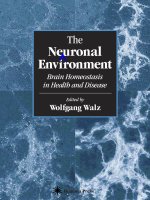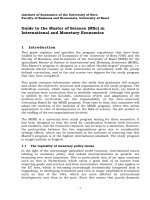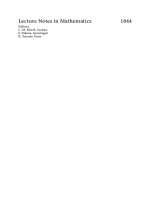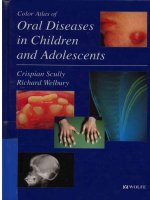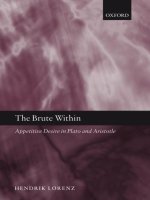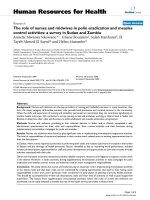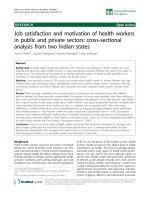The Potential of Biofumigants as Alternatives to Methyl Bromide for the Control of Pest Infestation in Grain and Dry Food Products
Bạn đang xem bản rút gọn của tài liệu. Xem và tải ngay bản đầy đủ của tài liệu tại đây (786.51 KB, 20 trang )
Chapter 16
The Potential of Biofumigants as
Alternatives to Methyl Bromide for the Control
of Pest Infestation in Grain and Dry Food
Products
Eli Shaaya and Moshe Kostyukovsky
Abstract Fumigation is still one of the most effective methods for the protection of
stored grain and dry food from insect infestations. Phosphine and methyl bromide
are the most widely used fumigants for the control of stored-product insects. Phos-
phine is mainly used today, but there are repeated reports that a number of storage
pests have developed resistance to this fumigant. Methyl bromide has been identi-
fied as a contributor to ozone depletion by the United Nations World Meteorological
Organization in 1995 and, thus, was phased out in most developed countries. Thus,
there is an urgent need to develop alternatives with the potential to replace these
fumigants.
The primary aims of the current study are to evaluate the potential use of essential
oils obtained from aromatic plants as insect fumigants and to evaluate the toxic-
ity of the known isothiocyanates (ITCs) as compared to a new ITC isolated from
Eruca sativa (salad rocket) as fumigants for the control of stored-product insects.
Also, the biological activity of carbon disulphide (CS
2
), methyl iodide (CH
3
I), and
benzaldehyde (C
7
H
6
O) is evaluated.
The toxicity of the various fumigants was assessed against adults, larvae, and
pupae of six major stored-product insects. Two essential oils isolated from Lami-
aceae plants were found to be the most potent fumigants as compared with a
large number of other essential oils. ITCs are also potential candidates, especially
methylthio-butyl isothiocyanate, the main bioactive component in E. sativa, because
of its low toxicity. Comparative studies with CH
3
I, CS
2
, and C
7
H
6
O showed that
CH
3
I was the most active compound against stored-product insects, followed by
CS
2
and C
7
H
6
O. CH
3
I was also found to be less sorptive and less penetrative in
wheat than CS
2
.
E. Shaaya (
B
)
ARO, the Volcani Center, Department of Food Science, Bet Dagan 50250, Israel
e-mail:
389
A. Kirakosyan, P.B. Kaufman, Recent Advances in Plant Biotechnology,
DOI 10.1007/978-1-4419-0194-1_16,
C
Springer Science+Business Media, LLC 2009
390 E. Shaaya and M. Kostyukovsky
16.1 Introduction
In developing countries, the post-harvest losses of cereals and other durable com-
modities caused by insect damage and other bio-agents range from 10 to 40% (Raja
et al., 2001).
Fumigation with methyl bromide or phosphine is a quick and effective tool for
the control of stored-product insect pests. In view of the scheduled phaseout of
methyl bromide under the Montreal protocol, the role of phosphine in grain pro-
tection has increased and stands as the main alternative to methyl bromide. Lately,
insect resistance to phosphine has become an important issue for effective grain
treatment (Nakakita and Winks, 1981; Tyler et al., 1983; Rajendran and Karanth,
2000). A global survey of pesticide susceptibility demonstrated that 9.7% of the
strains tested showed resistance to phosphine (Champ and Dyte, 1976). Another
compound, 2,2 dichlorovinyl dimethyl phosphate, which is widely used as a fog
fumigant for insect control in empty structures, is classified by the US Environ-
mental Agency as a possible human carcinogen (Mueller, 1998). Therefore, there
is an urgent need for new strategies. Thus, in recent years, research has focused on
a search for alternative fumigants for the control of stored-product insects. In this
chapter, we present a comprehensive laboratory and semi-field studies to evaluate
the potential use of essential oils (EOs) obtained from aromatic plants and isothio-
cyanates (ITCs), methyl iodide (CH
3
I), carbon disulfide (CS
2
), and benzaldehyde
(C
7
H
6
O) for the control of stored-product insects.
During previous centuries, traditional agriculture in developing countries has
developed effective means for insect control using botanicals. Their efficiency and
optimal use still need to be assessed in order to make these means of insect control
cheap and simple for users. Lately, a new field has evolved which emphasizes the
use of phytochemicals for insect pest management. The bioactivity of essential oils
(EOs), the major volatile in aromatic plants, and their constituents, has been well
documented against a large number of insect pests. An example is the EO obtained
from the leaves of Thugopsis dolabrata hondai which was found to have high bioac-
tivity against the cockroach (Periplaneta fuliginosa), the mite (Dermatophagoids
farinae), and the termite (Coptotermes farmosanus) (Asada et al., 1989; Lee, 2004).
Some EOs were found to exhibit repellent activity against various insects (Kalemba
et al., 1991; Hassalani and Lwande, 1989; Mwangi et al., 1992). Others were found
to be potent growth inhibitors and anti-feedants (Jermy et al., 1981; Koul et al.,
1990). These essential oils were also found to be effective as nematicidal (Oka et al.,
2000), anti-bacterial (Matasyoh et al., 2007), virucidal (Schuhmacher et al., 2003),
and repellents against ectoparasites (Mumcuoglu et al., 1996).
The efficacy of essential oils as fumigants for the control of pest infestations
in grain and dry food products was also evaluated. EOs and their constituents are
known to possess insecticidal (Wilson and Shaaya, 1999; Shaaya et al., 1997) and
insect repellent activity (Jilani et al., 1988) and to cause a reduction in progeny
(Regnault-Roger and Hamraoui, 1995). For example, the fumigant toxic activity,
anti-feedant, and reproduction inhibition induced by a number of EOs and their
monoterpenoids were evaluated against the bean weevil Acanthoscelides obtectus
16 Biofumigants for the Control of Pest Infestation 391
(Say) and Callosobruchus maculatus (F.) (Klingauf et al., 1983; Regnault-Roger
and Hamraoui, 1995; Raja et al., 2001). EOs extracted from Pogostemon heyneanus,
Ocimum basilicum (basal), and Eucalyptus showed insecticidal activity against
Sitophilus oryzae, Stegobium paniceum, Tribolium castaneum, and Callosobruchus
chinensis (Deshpande et al., 1974; Deshpande and Tipnis, 1977).
In our laboratory, in order to isolate active EOs, we screened a large number of
EOs extracted from aromatic plants and isolated their main constituents. We have
already isolated many such compounds from the EOs of a large number of aromatic
plants (Shaaya et al., 1991, 1994, 1997). Using space fumigation (see Shaaya et al.,
1997), two EOs obtained from Lamiaceae plants were found to be the most potent
fumigants of all oils tested. The main component of one of the oils is pulegone. The
other is not yet identified and it is called SEM76 (Shaaya and Kostyukovsky, 2006).
In our study of the mode of action of EOs, we could show that the target for
EO’s neurotoxicity is the octopaminergic system in insects. We can thus postulate
that EOs may affect octopaminergic target sites (Kostyukovsky et al., 2002; Shaaya
et al., 2002).
ITCs were chosen for this study because of the pesticidal properties of these
chemicals (Fenwick at al., 1983) and because of the potential use of methyl ITC as
fumigant for wheat (Ducom, 1994). In our study on the rates of sorption of homol-
ogous series of ITCs on wheat, we could show that the rate of sorption decreases
with increasing molecular weight (Shaaya and Desmarchelier, 1995). In the case of
methyl ITC, a withholding period over 1 week would be required before residues
decayed to levels near the limit of detection (Shaaya and Desmarchelier, 1995).
Comparative studies with CH
3
I, CS
2
, and C
7
H
6
O showed that CH
3
Iwasthe
most potent compound against stored-product insects, followed by CS
2
and C
7
H
6
O.
CS
2
, according to Winburn (1952), was one of the most effective grain fumigants
as viewed from efficiency and low cost points of view. C
7
H
6
O occurs in kernels
of bitter almonds, has low toxicity to mammals, and has widespread use in topical
antiseptics.
16.2 The Materials and Methods
The materials and methods employed in the current study are described as follows.
The tested stored-product insects were laboratory strains of S. oryzae, Rhyzop-
ertha dominica, Oryzaephilus surinamensis, T. casteneum, Trogoderma granarium,
Plodia interpunctella, and Ephestia cautella.
The isothiocyanates (ITCs) are obtained by putting 100 g ground seeds into round
bottom flask containing buffer solution (1% ascorbic acid). The flask is held in a
water bath (temperature = 70
◦
C) for 2 h to facilitate the hydrolysis of sinigrin to
ITC by the enzyme myrosinase which is found inside the seeds. The second step
is steam distillation with use of the Dean–Stark apparatus (Leoni et al., 1997). The
yellow upper layer is then separated and extracted with petroleum ether. Finally,
the petroleum ether is evaporated under a stream of air. The unknown ITC obtained
392 E. Shaaya and M. Kostyukovsky
from the seeds of E. sativa was identified as methyl thio-butyl isothiocyanate by gas
chromatography (GC), nuclear magnetic resonance (NMR), and infra-red (IR) spec-
troscopy. CS
2
,CH
3
I, and C
7
H
6
O were purchased from Sigma Chemical Company,
St. Louis, MO, USA. The essential oils from the aromatic plants were obtained from
freshly harvested leaves and stems by steam distillation.
Three types of bioassays were performed to evaluate the activity of the fumi-
gants. The first screening of the compounds was space fumigation in glass chambers
of 3.4-L capacity (for details see Shaaya et al., 1991). The highly active compounds
were then assayed in 600-mL glass chambers, filled to 70% by volume with wheat
(11% moisture content). Pilot tests were carried out in simulation glass columns of
10 cm in diameter × 120 cm in height, filled to 70% by volume with wheat (11%
moisture content). The insects were introduced in cages, each holding 20 insects
of the same species together with food. Groups of four cages were suspended by a
steel wire at different heights from the bottom of the column. Percentage of insect
mortality was then determined.
The essential oils (EOs) of aromatic plant families are volatiles that can be easily
extracted by hot water vapors. The main components of the EOs are monoterpenes
and, to a lesser extent, sesquiterpenes (Brielmann et al., 2006). The majority of EOs
contain a limited number of main constituents, although minor compounds in the
oil can also play an important role in the fragrance and biological activity.
In order to isolate bioactive EOs, we screened a large number of EOs extracted
from aromatic plants and isolated their main constituents by methods cited in
Shaaya et al. (1991, 1994, 1997). Using space fumigation methodology, the two
EOs obtained from our experimental Lamiaceae plants were found to be the most
potent fumigants as compared with all other essential oils obtained from a large
number of aromatic plant species tested against stored-product insects (Table 16.1)
.
Table 16.1 List of aromatic plants whose essential oils were tested for bioactivity
Species Family Species Family
Apium graveolens Apiaceae Micromeria fruticosa Lamiaceae
Artemisia arborescens Compositae O. basilicum Lamiaceae
A. judaica Compositae O. gratissimum Lamiaceae
Carum carvi Apiaceae Origanum vulgare Lamiaceae
Citrus limonum Rutaceae
Pelargonium
graveoleus
Geraniaceae
Coriandrum sativum Apiaceae Petroselinum crispum Apiaceae
Cuminum cyminum Apiaceae Pimpinella anisum Apiaceae
Cymbopogon citrates Poaceae Rosmarinus officinalis Lamiaceae
Foeniculum vulgare Apiaceae Ruta chalepensis Rutaceae
Laurus nobilis Lauraceae Salvia dominica Lamiaceae
Lavandula officinalis Lamiaceae Salvia fruticosa Lamiaceae
Majorana siriaca Lamiaceae Salvia officinalis Lamiaceae
Matricaria camomilla Asteraceae Salvia sclarea Lamiaceae
Mentha piperita Lamiaceae Satureja thymbra Lamiaceae
M. rotundifolia Lamiaceae Thymus vulgaris Lamiaceae
16 Biofumigants for the Control of Pest Infestation 393
Table 16.2 Fumigant toxicity of SEM76 and pulegone on some stored-product insects (space
fumigation)
Exposure time –24 h.
Third instar larvae and 3-day old pupae were used.
The main component of one of the oils was pulegone and of the other is not yet
totally identified, and it is called SEM76. In space fumigation, these two volatiles
caused total mortality of all adults tested at very low concentrations of 0.5 μL·L
−1
air and exposure time of 24 h. A higher concentration of 4 μL·L
−1
air was needed
to kill larvae of Tribolium, Trogoderma, and Plodia. Limonene which is regarded as
active monoterpene has much lower activity (Table 16.2).
Table 16.3 Fumigant toxicity of SEM76, with and without CO
2
, against five stored-product
insects on winter wheat, in columns 70% filling, in pilot tests
% Mortality (7 days after treatment)
Stage
Concentration,
μL·L
−1
Sitophilus Tribolium Oryzaephilus Rhyzopertha Plodia
Adults 70 100 66 100 70 –
50 + 15%
CO
2
100 96 100 100 –
70 + 15%
CO
2
100 100 100 100 –
Pupae
70 + 15%
CO
2
– 75 – – 100
Larvae 70 – 60 – – 87
70 + 15%
CO
2
– 80 – – 100
Exposure time – 7 days.
394 E. Shaaya and M. Kostyukovsky
Pilot tests in simulation glass columns filled to 70% volume with wheat, under
conditions similar to those present in large grain bins, showed that SEM76 at a con-
centration of 70 μL·L
−1
air (equivalent to 70 g·m
−3
) and 7 days exposure time
caused 100% kill of adults of Sitophilus and Oryzaephilus, but not of Rhyzop-
ertha and Tribolium (Table 16.3). Supplementation of 15% CO
2
(200 g·m
−3
) caused
reduction in the effective volatile concentration. A concentration of 50 μL·L
−1
air
was enough to cause 96–100% kill of all adult insects tested. For pupae and larvae
of Tribolium and Plodia, a higher concentration is needed (Table 16.3).
16.3 Efficacy of Isothiocyanates (ITCs) as Fumigants
for the Control of Pest Infestations in Grain
and Dry Food Products
Mustard family (Brassicaceae) seeds contain ITCs, volatile essential oils that are
known to possess insecticidal activity. By screening a number of various species of
Brassicaceae seeds, namely, Brassica nigra, B. carinata, B. tournefortii, Lepidium
Table 16.4 The fumigant toxicity of four active isothiocyanates compared with methylthio-butyl
ITC against adults of major stored grain insects. (Space fumigation)
Methylthio-butyl ITC was isolated from the plant Eruca sativa.
16 Biofumigants for the Control of Pest Infestation 395
sativa, Sisymbrium irio, Sinapis alba, S. arvensis, E. sativa, and Diplotaxis spp.,
only in the last three species was it possible to isolate from the seed oil an unknown
ITC at concentrations of 98, 92, and 33%, respectively. Later, this compound was
identified as methylthio-butyl ITC. In space fumigation, the biological activity of
this compound was compared with four common ITCs, namely, allyl, methyl, butyl,
and ethyl. Allyl and methyl ITCs were found to be the most active against adults of
four stored-product insects. A concentration of 1 μL·L
−1
air and exposure time of
3 h were enough to kill all the tested adult insects. The activity of methylthio-butyl
ITC was comparable to that of allyl and methyl ITCs except for Tribolium, which
was found to be much more susceptible to the two ITCs (Table 16.4).
In the case of Plodia larva also, a concentration of 1.5 μL·L
−1
air of the three
active ITCs and exposure time of 3 h were enough to get 100% kill. For larvae of
Tribolium and Trogoderma, a higher concentration of 2.5 μL·L
−1
air and exposure
time of 3 h were needed. The pupae of these three insect species were the most
resistant to the ITCs tested (Table 16.5).
Using high columns filled to 70% wheat to evaluate the toxicity of allyl ITC
in grain, we could show that 20 μL·L
−1
air (=20gm
−3
) and exposure time of
1 day were not effective in killing the insects at the bottom of the column when the
fumigant was applied at the upper layer of the grain. Addition of CO
2
and circulation
caused 100% kill at the different heights. Increasing the exposure time to 4 days and
cycling was enough to obtain 100% kill (Table 16.6).
Table 16.5 The fumigant toxicity of four active isothiocyanates compared with methylthio-butyl
ITC against larvae and pupae of major stored grain insects. (Space fumigation)
Methylthio-butyl ITC was isolated from the plant Eruca sativa.
Third instar larvae and 3-day old pupae were used
396 E. Shaaya and M. Kostyukovsky
Table 16.6 Toxicity of allyl ITC against stored-product insects, using high columns filled with
70% wheat with and without CO
2
16.4 Efficacy of CH
3
I, CS
2
,andC
7
H
6
O as Fumigants
for the Control of Stored-Product Insects
In space fumigation, CH
3
I was very effective against all insect stages tested. Expo-
sure to a concentration of 3–5 μL·L
−1
for 3 h was lethal and caused 100% mor-
tality of all stages of the test insects, except for Trogoderma larvae (Table 16.7).
Adults of Tribolium were found to be the most tolerant, followed by Oryzaephilus,
Rhyzopertha, and Sitophilus. In the case of larvae and pupae, Trogoderma was the
most tolerant, followed by Tribolium and Plodia (Table 16.7).
CS
2
was less effective than CH
3
I and needed a concentration of 6–9 μL·L
−1
air for 1 day to achieve total mortality of all the test insects except for Trogoderma
larvae. In the case of CS
2
, adults of Tribolium were found to be the most resistant,
followed by Sitophilus, Oryzaephilus, and Rhyzopertha. The larvae of Trogoderma
were more resistant than Tribolium (Table 16.8).
In experiments with 600-mL glass chambers filled to 70% volume with wheat,
CH
3
I also showed higher activity than CS
2
. The concentration of CH
3
I and expo-
sure time needed to obtain a total mortality of the test insects were comparable to
those in space fumigation tests (see Table 16.7). For CS
2
, higher concentrations

